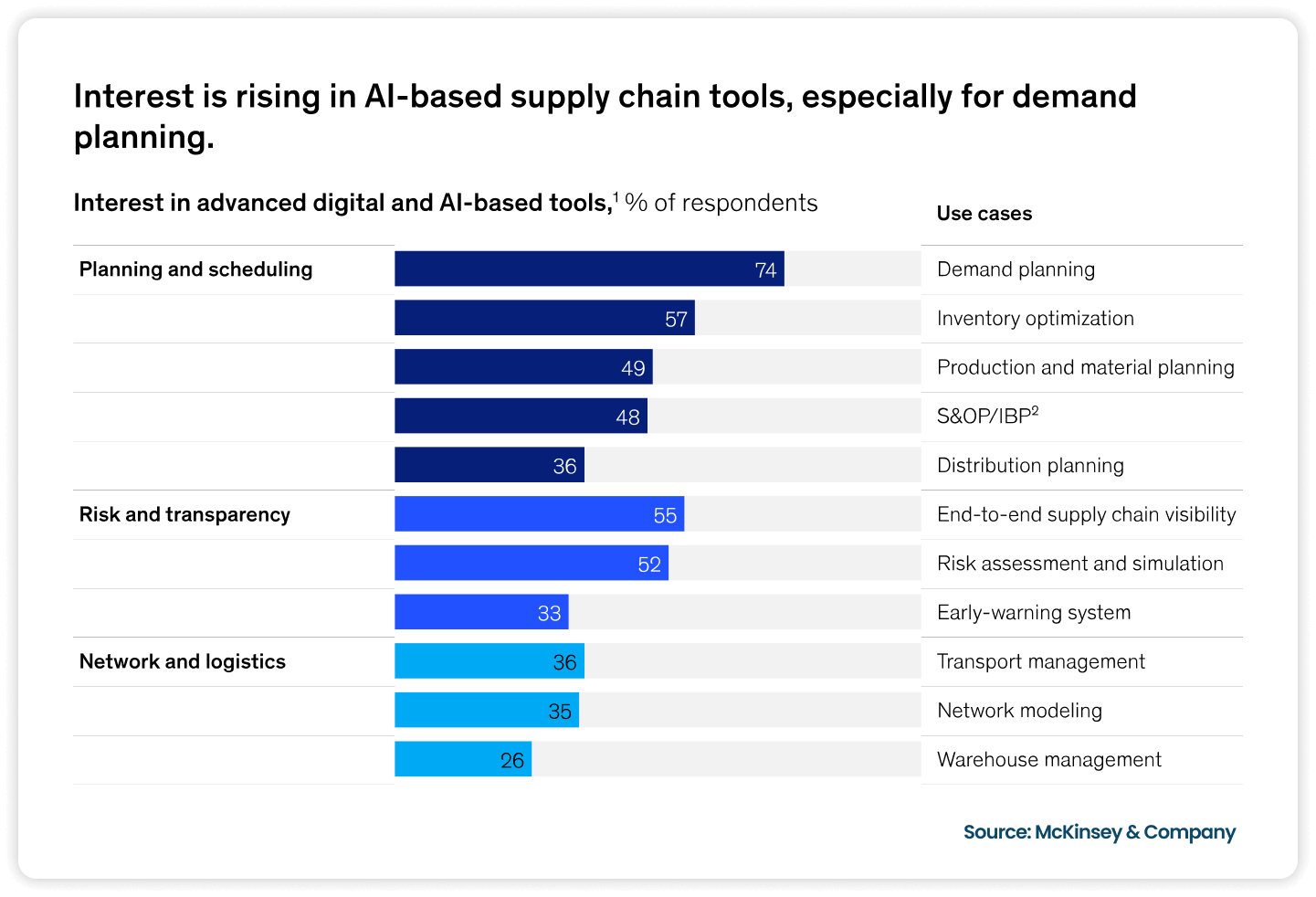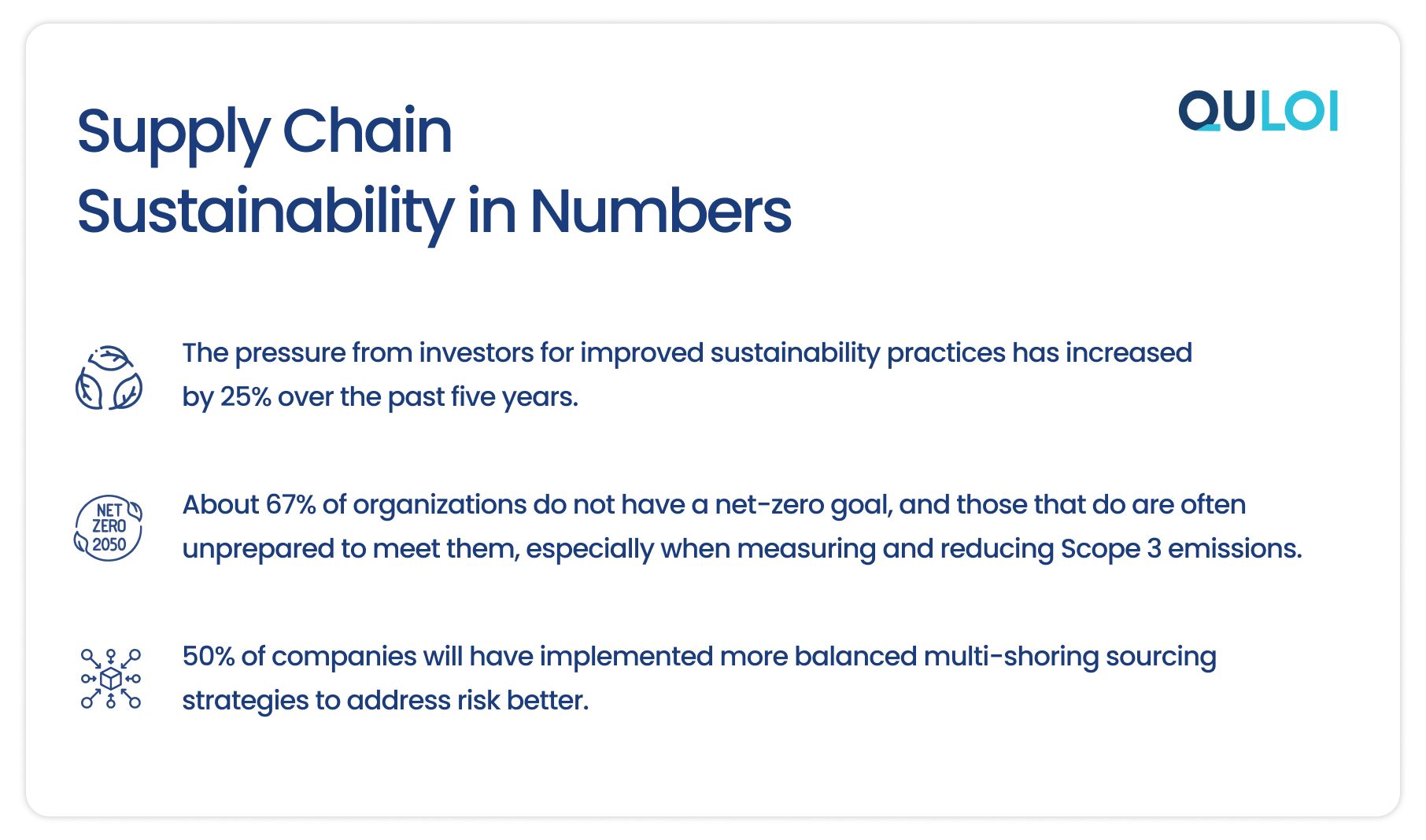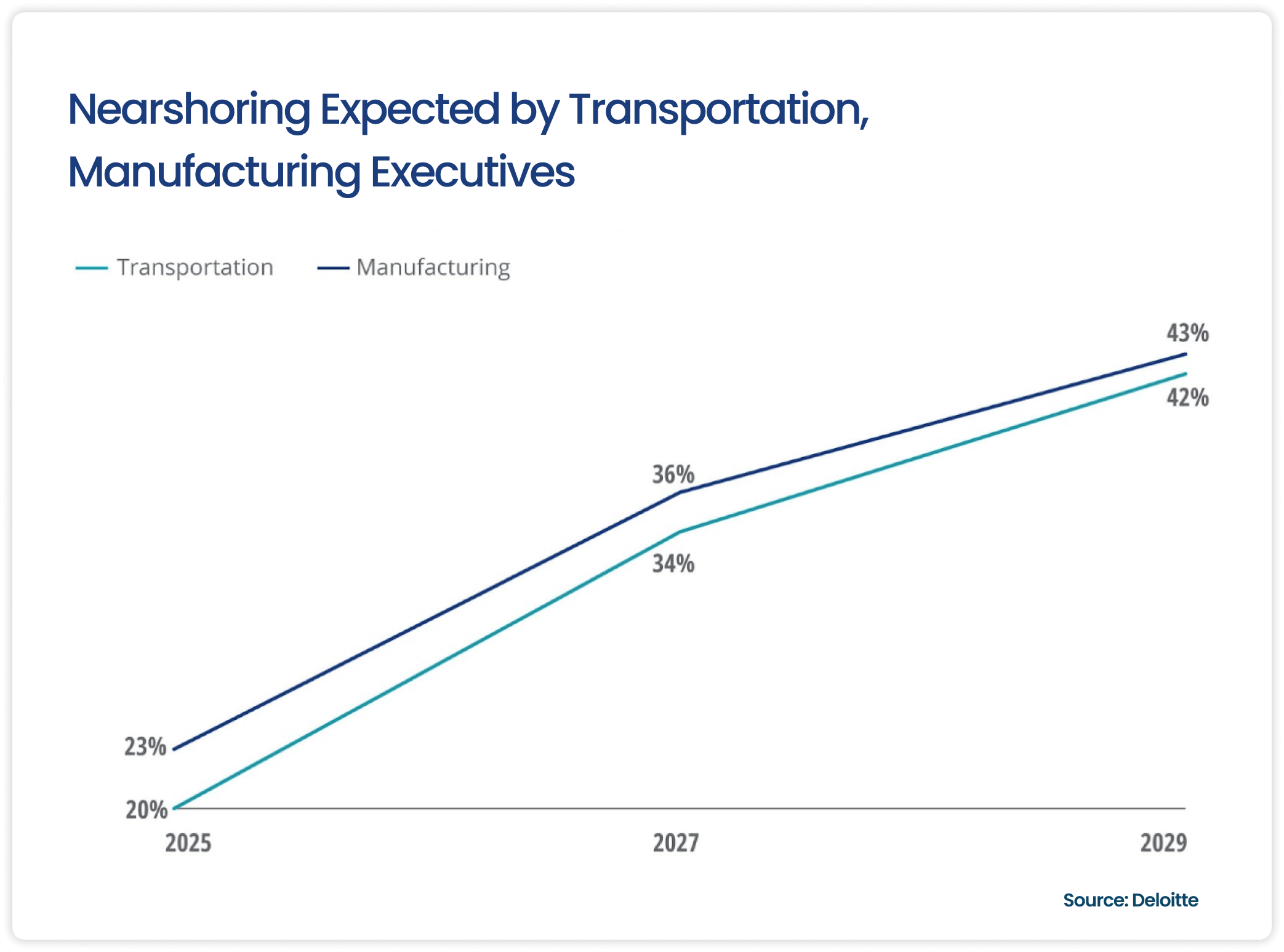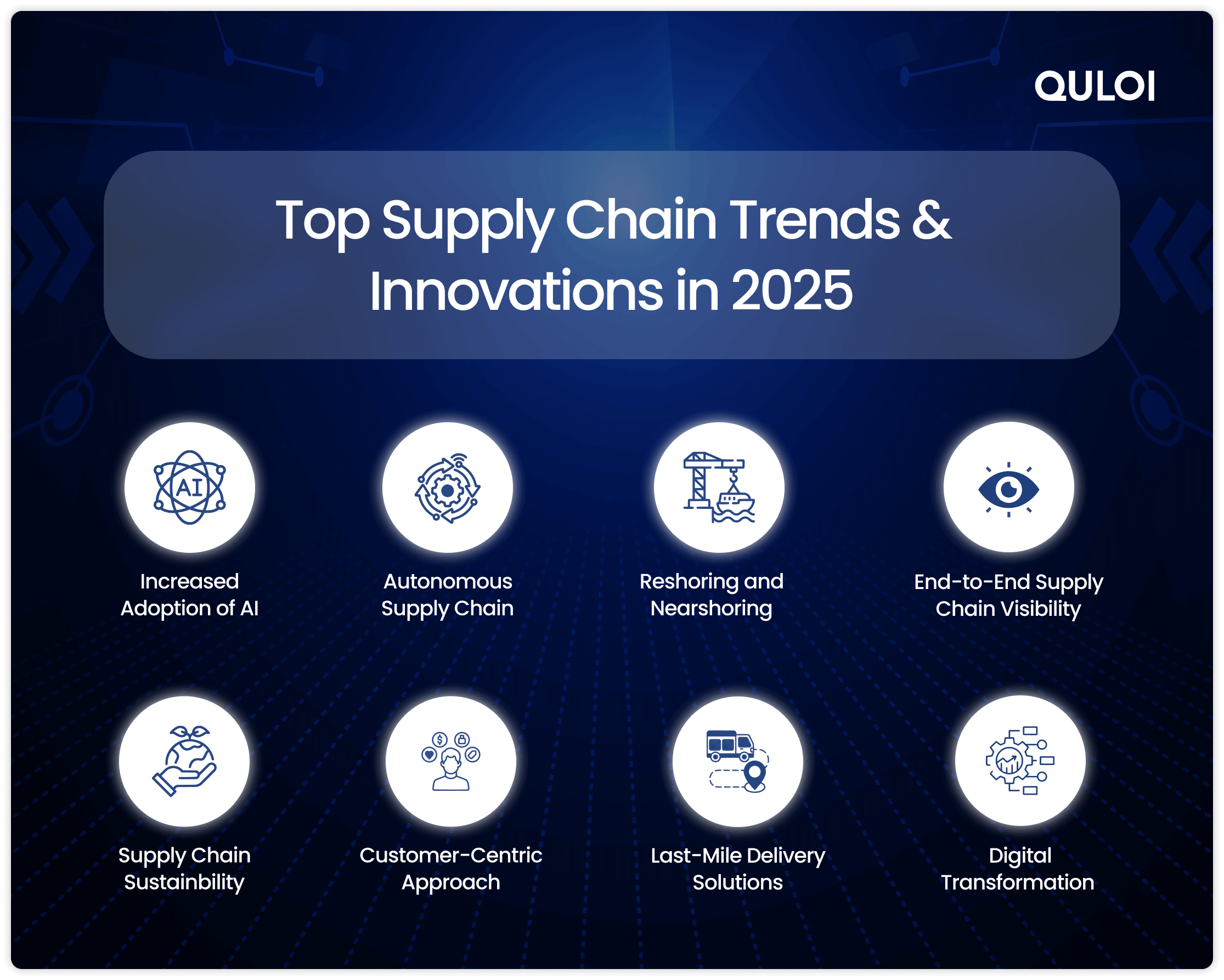2025 has arrived, and so has the new wave of exciting business opportunities with challenges in the supply chain space. Driven by technological advances and changing global dynamics, supply chain organizations are poised for significant evolution in the new year. But as the confetti settles, the question is, what will the most crucial supply chain trends be in 2025?
While there is no crystal ball, a few trends will likely dominate the supply chain over the next 12 months and beyond. As a supply chain leader, you always want to stay ahead of the curve when making timely decisions in changing market dynamics. With this in mind, this blog will look at a few supply chain trends that will shape supply chains in 2025 and potentially beyond.
Supply Chain Trends for 2025
Let us explore the key trends likely to influence supply chains in 2025, providing insights to help companies modernize and work towards more resilient, responsive, flexible, and transparent supply chains.
AI Advancement: Artificial Intelligence presents opportunities to transform supply chains through innovation and optimization. While the traditional AI approach has been integrated into supply chain processes for years, the Gen AI advancement has unlocked transformative potential for operational efficiency, responsiveness, and resilience. According to a McKinsey survey, AI tools are already shaping organizations, including digitization plans, as evidenced by significant interest in demand-planning tools. AI systems can automate the analysis of disparate data sources from logistics providers, in-house demand forecasting systems, etc. Another AI opportunity is in early-warning systems for potential supply chain risks that evaluate data from social media traffic, supplier information, long-range weather forecasts, etc.

Enhanced Supply Chain Visibility: Visibility will no longer remain a buzzword for supply chains. It will create a paradigm where organizations can be proactive and responsive towards addressing inefficiencies. According to McKinsey, 60% of organizations reported comprehensive visibility into their direct suppliers. This determines a significant improvement in supply chain management capabilities. With real-time visibility, it has become possible to map shipping routes that pose the lowest risk and reduce the chance of cargo damage in transit. Real-time shipment visibility will become an integral part of supply chains to help organizations optimize the use of vehicles and other resources. For example, granular level details in loading and unloading schedules will help reduce detention and demurrage costs and enable accurate and timely deliveries.
Sustainability: A sustainable supply chain will be more than just staying compliant; it will become an integral part of business strategy. Supply chain organizations will focus on adopting renewable energy, reducing carbon emissions, and using recycled materials in production and packaging. According to a survey, over $3.5 billion will be spent to reduce pollution, accelerate the demonstration and deployment of direct air capture technologies, and reinforce the global competitiveness of the US. With the energy intensity of many carbon removal pathways, continued innovation to curb carbon emissions will be important as electricity demand rises.

Nearshoring and Reshoring Strategies: The disruptions caused by global events have prompted many companies to adopt nearshoring, diversify supplier networks, and embrace multi-sourcing to enhance adaptability, continuity, and cost efficiency. Nearshoring—relocating production closer to key markets—allows organizations to mitigate international shipping chaos. Prioritizing localized production capacity helps companies reduce risks like long lead times, tariffs, and geopolitical tensions. A survey by Deloitte stated that transportation companies anticipate 20% of Asia-originating freight will move to closer proximity markets by 2025, doubling to 40% of freight originations by 2030. Manufacturers’ expectations are similar, and 62% have already started the nearshoring process. This approach can help drive operational and procurement productivity through increased visibility and control in shipping and distribution.

Digital Transformation: The rollout of advanced technology, like machine learning, advanced analytics, artificial intelligence, etc, will be a game changer for supply chains in 2025. Real-time data analytics will enable organizations to anticipate disruptions and proactively optimize shipping routes. Blockchain technology has also taken center stage as it increases visibility and transparency to help reduce fraud in logistics operations. Automation technologies in day-to-day supply chain management will be a dominant force in the digital transformation journey. Similarly, using cloud technologies will be a critical enabler in driving supply chain and logistics success.

Customer-Centric Approach: It’s easy for businesses to get swept up in the day-to-day pursuit of profit-driven outcomes, higher ROI, and more prominent bottom lines. While organizations must be forward-thinking and profit-driven, organizations focusing solely on generating revenue typically fall short of creating long-term, sustainable business growth. After all, chasing profit doesn’t translate to long-term success. Owing to the disruptions in the ecosystem, the supply chain of the future will need to be integrated, customized, autonomous, and powered by data to serve new customer channels and adjust to changing scenarios. Moreover, organizations will adapt to technology-driven ways to analyze consumer data and predict trends.
Last-mile Delivery Solutions: The pressure to offer fast, reliable, top-notch quality, and flexible delivery services is real. Smart cities can’t sit back and relax just by delivering packages to the doorsteps within the shortest time. Last-mile delivery will go beyond just on-time delivery; it will also be about providing transparency, sustainability, and value. With the explosive growth of e-commerce, the global last-mile delivery market is projected to reach $258.68 billion by 2030. Supply chains focusing on efficiency and sustainability will be uniquely positioned to address delays, high costs, and environmental impacts. Companies will leverage drones, autonomous delivery vehicles, and smart lockers to meet customer needs for faster, more convenient, and more reliable delivery.
To conclude, the future of the supply chain in 2025 will undoubtedly shaped by technological innovations, customer-centric approaches, and fail-proof leadership approaches. Organizations that adopt the best supply chain solutions will be poised to stand out from the competition. 2025 isn’t just another year; it’s an opportunity to push boundaries, rethink your supply chain solutions, and set the pace for what’s next.
Quloi is all set to drive your supply chain transformation by helping you achieve optimized lead times, end-to-end supply chain visibility, real-time collaboration, and much more. Book a FREE Demo to learn more about Quloi’s supply chain solutions for your business growth.